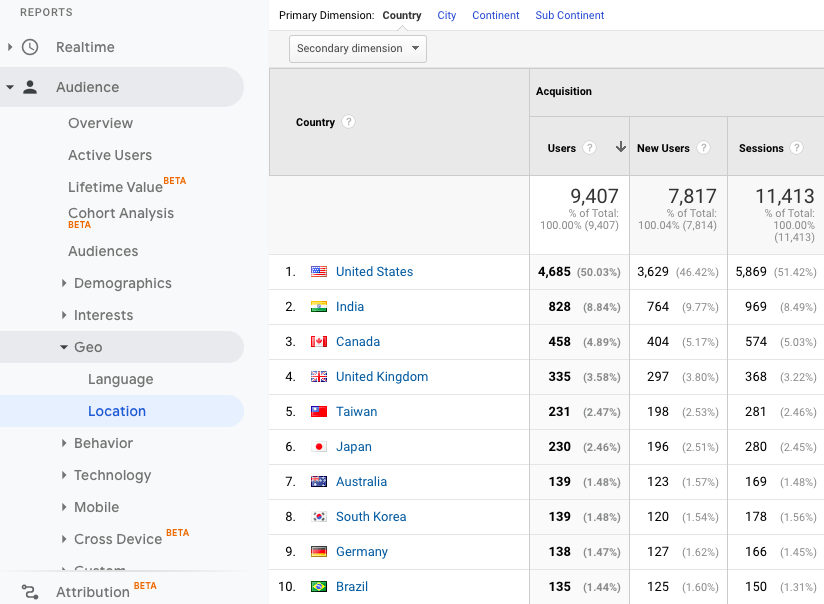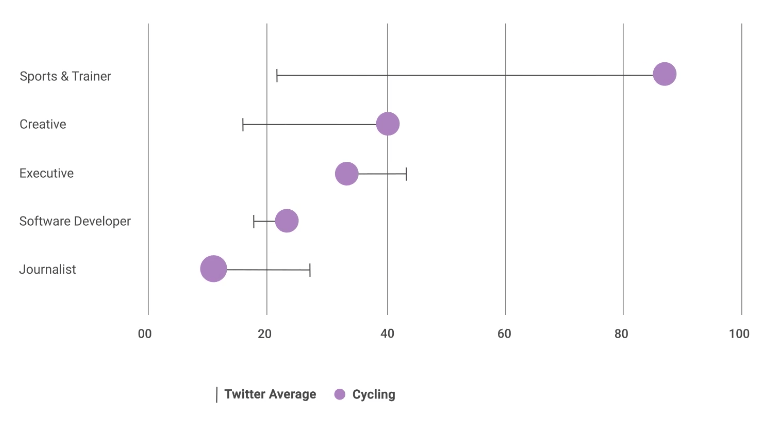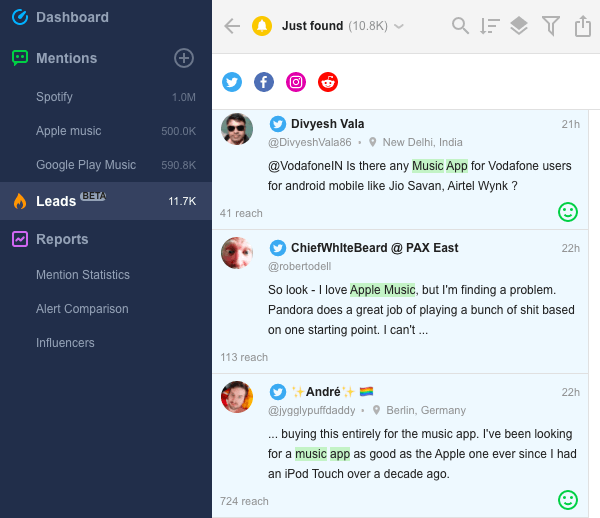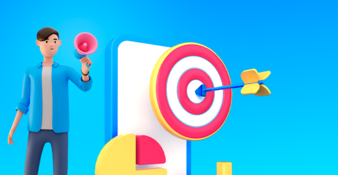How to create customer personas: 5 steps + template

Article summary
In this article, we explain what is customer persona, why defining persona is so important, and give you buyer personas examples and a template to design your own.
What do marketers and Ingmar Bergman circa 1966 have in common? We're all about personas.
Marketing persona, customer persona, buyer persona, audience persona are all sides of the same 4-sided coin — the people we serve content, services, and products to. They're the living, beating heart of every marketing operation because ultimately, any marketing strategy is built around customers, existing and potential.
While the objective is clear — putting the audience first — sorting out the specifics often gets messy. The terminology is ambiguous, methods vary, and priorities aren't always straightforward. To help you navigate the troubled waters of putting the audience first, I invite you on a step-by-step tour around customer personas. Below are some of the landmarks to look forward to.
- What is a customer persona and how is it different from similar terms?
- Why are customer personas so important?
- How do you create a customer persona?
- How do you use social listening in creating customer personas?
- If nothing makes sense, where do you find a free consumer personas template?
Ready? Let's hit the road then.
By signing up I agree to the Terms of Use and Privacy Policy
What is a customer persona (and what about other terms)?
First things first: marketing, customer, buyer, and audience personas are indeed sides of the same coin. By this, I mean that choosing the term is a matter of perspective, while the essence remains the same.
Marketing, customer, buyer, and audience personas are used interchangeably to define the best members of your target audience.
It might be that a marketer favors the term marketing persona, a sales team prefers the buyer persona option, and a PR pro uses audience persona the most — or not at all! The question is of personal preference rather than fundamental differences in definitions, of which there are none.
If we go on with parallels between marketers and filmmakers, we can think of a buyer persona as a lead actor. For one, a buyer persona and a lead in a movie are both fictional characters. Second, they each embody a number of characteristics or traits that make up a trope. Much like a lead actor, a customer persona is supposed to represent the best version of a character — a perfect prospective buyer in this case — and guide marketers towards other buyers that match the criteria.
A rough sketch of a buyer persona template looks something like this:
- name,
- age and gender,
- location and languages,
- occupation and interests,
- pain points and goals,
- behavioral characteristics,
- spending patterns, etc.
Depending on how much detail you have on your perfect buyer, the rough sketch will evolve into a nuanced portrait that will guide your marketing and business decisions. To move from theory to practice, let's move to the use cases.
1. Why are customer personas important?
Customer personas are important because they help marketers see people in their audiences. When researching a target audience, it's easy to get caught up on metrics and start perceiving an audience as a homogenous entity. The thing about audience research is that it calls for a granular approach, where a target market is studied layer after layer, with key buyer personas representing each customer segment meaning you can cover all of them!
Another thing about audience research is that most businesses do have multiple customer profiles to worry about. Unless what your business does is so specific that there's only one buyer profile to think of (scroll up a notch in case you need another look at what constitutes a customer persona), understanding your customer segments in all their variety is crucial to making sense of what your target audience is all about.
Although buyer personas are fictional, they're meant to represent real people behind your target audience. Having thoroughly developed buyer personas — people with names, aspirations, and needs — helps build a more humanized marketing workflow.
Customer personas enhance content strategy
The key to creating enticing content is putting customer hopes and pain points at the heart of your content marketing. Understanding your buyer persona profile helps you improve your content and is able to inspire you when you come across a creative block.
Customer personas improve SMM strategy
Same here — by having an instructive user persona example, you can connect with your customers through the channels they favor the most. You can even break down customer personas by different platforms and address them individually in your social media strategy.
Customer personas help create compelling ads
Brand personas mean better-targeted ads! Instead of trying to create one ad that appeals to everyone and no one in particular, you'll be able to adjust everything — your copy, visuals, and call-to-action— to your potential customers.
Customer personas boost your ad targeting
Speaking about ads, buyer personas can also help you make sure your ads will reach exactly the people that will click on them. You can choose the settings that are directly aimed at your customer personas, test what works and what doesn't and tweak them accordingly.
All of these serve the purpose of shifting the focus from company needs to customer needs when framing messages and developing marketing campaigns and, ultimately, products and services.
Since the absolute majority of businesses have several buyer personas in their audience, it's unrealistic to expect that each persona's needs and wants will be equally prioritized every time you're considering a marketing move. However, making sure at least one of your buyer personas is fully covered is a good starting point.
2. What should be in a customer persona?
Creating a customer persona is all about collecting the data that constitutes one. Approaches to gathering that data vary, but ultimately, it all boils down to knowing your sources and mastering the tools. Let's take a closer look at where you could be getting data points from.
Name
While giving your best potential customer a name might seem like an overstretch, it actually makes all the difference when thinking of your buyers as real people. Giving an actual name to your buyer persona template prevents you from thinking about them as numbers and facts on a list. You can even give them a nickname to better describe their interests and pains. Something like Dave the Tech Geek is much better than "a male in mid-30-s who's interested in technology".
You might have a couple of names in mind after conducting demos or interviews, you might make one up based on your personal associations, or you might turn to the list of popular names or some other directory.
Some marketers prefer assigning common, generic names to their buyer personas, some favor alliterations and plosives — choose whatever feels right for you and stay away from celebrity or famous fictional character names to avoid confusion and confusing associations.
By signing up I agree to the Terms of Use and Privacy Policy
Age and gender
Age and gender are the most basic components of demographic data used to define an audience persona. While you could, of course, gather this data from demos and interviews, there's a much smoother way that goes by the name of social media analytics.
From a native tool like Facebook Audience Insights to a social listening tool like Awario or Talkwalker, collecting age and gender data boils down to choosing an audience to study and fetching analytics based on the users' ongoing social media activity.


With a social listening tool, all you need to do is create a project, set up a monitoring alert using your brand name, campaign hashtag, or any other keyword that links to your audience. Then, it's only a matter of time (depending on how many keywords and sources you're monitoring) before you have all the social data analytics presented in a neat dashboard.
Awario empowers you to run audience research non-stop, so be sure you'll be using it way past creating customer personas, especially when we've implemented age (in addition to gender) insights in a couple of months!
Location and languages
Understanding where your perfect buyer is located and what languages they use is a crucial part of putting together a buyer persona. Similar to other demographic data, it's best sourced via social media analytics tools as they provide real-user data and let you ground your buyer persona choices in your actual audience members.
Alternatively, you could fetch locations and languages data, among other user data, from Google Analytics. By going through Audience reports, you get to geo insights, specifically languages and locations. Armed with those, you can complete your customer personas with further demographic info.

You can also find this data in Awario. Moreover, you can focus your analysis in a particular country, area, or city and find is your customer personas are represented there.

Job title
Occupation is an extremely important attribute for your user personas example, especially if you're working with B2B companies. Obviously, if you're trying to find B2B customers, knowing your client's job title is essential to making a relevant offer, but even for B2C businesses, it stays relevant. You can better imagine your customers' lifestyle whether they commute and how, what worries them during the day, and more.
Spending patterns
Spending patterns are behavioral patterns put in USD (or any other currency you're operating with). When defining a buyer persona, it's important to understand what kind of resources they have and what kind of expenditures they're used to. To determine buying patterns, you could use a spending calculator or turn to household expenditure stats. Alternatively, you could go through your perfect customer's day-in-the-life once again, with a special focus on purchases, daily transactions, and the room left for products similar to yours.
Spending patterns also can be determined based on the purchases inside your product and website, so don't be afraid to mine your own CRM software for data.
Interests
Interests are one of the primary social characteristics that constitute a buyer persona. If you don't have this kind of information from the now infamous demos and interviews, you can always rely on social media listening and analytics software like Brandwatch. Among other audience insights, it delivers interests of not only your existing customers but also potential ones, empowering you to research your perfect buyers with minimum effort.

Pain points
Pain points are the psychological characteristics that go into a buyer personas template and help marketers understand customers' motivations in relation to particular products. Psychological characteristics are the trickiest to study even through face-to-face interviews, let alone questionnaires or opinion polls.
On this blog, we've demonstrated over and over again the power of sentiment analysis and the Topic cloud as a means of researching the attitudes, concerns, and aspirations within an audience. To determine your customer persona's pain points, you're welcome to experiment with Awario's audience analysis tools — or try other tools that perform similar tasks.
You can also access this information by talking to your customer support team — they are constantly asked questions based on your customers' needs, so you can request some sort of FAQ to represent buyer persona questions.
Goals
Goals and aspirations are the opposite of pain points — there are positive changes your target audience wants to achieve. Goals might be directly related to solutions you can provide, but they don’t have to be. Sometimes you may discover that your offer exceeds the goals of your customers, or maybe turns them in a slightly different direction that is more beneficial to them. You just have to prove it to them.
Social listening can be a good way to define your customers' aspirations. Dive deep into the mentions of your brand, competitors, and industry to find what's your audience is anticipating.
The sales team can be a good source of insight on customer goals as well so don't neglect their input.
Challenges and fears
Similar to pain points, challenges and fears are also psychological characteristics of your customer persona, however, this time it explains not why a customer needs the product, but quite the opposite — what stops them from purchasing. It can be the price, the service, the doubts about its necessity, or anything else.
By identifying these, you'll know how to address and deal with these in your marekting and sales activities.
Behavioral characteristics
Behavioral characteristics of a buyer persona are meant to illustrate patterns of behavior meaningful to the marketing journey you're creating. A common technique used by marketers to establish behavioral patterns of their ideal customer is constructing a day-in-the-life. As the name suggests, it serves the purpose of describing a daily sequence of events and activities your buyer persona would go through, therefore establishing how your products or services could be of use to them.
One segment of behavioral characteristics valuable to any marketer at any point of campaign development is online behaviors.
- What social networks does your customer persona favor?
- What kind of content do they engage with the most?
- Which influencers and opinion leaders they follow?
These are some of the questions that set the direction here. The more behavioral analytics you can gather, the better you understand your perfect buyers. With these insights on hand, you can improve your targeting, content, and SMM strategy, and approach your customers in ways that feel the most natural to them.

How we can help
Now that you understand your customers’ pain points and goals, it’s time to create a really clear picture of how your products and customer support team can help. As part of this step, you’ll need to stop thinking about your brand in terms of features and dig deep to analyze the benefits you offer to customers. Ask yourself questions for each of the pain points and goals collected:
-
How can we help? Capture that in one clear sentence and add it to your consumer personas template.
-
What are customers' main purchasing obstacles? And how can you help overcome them?
-
Where are your followers in their buying journey? Are they researching or ready to buy? Looking for reviews?
The answers to these questions added to your customer persona help marketers craft a marketing message that would tell this persona what the company does and how it helps them. Here's a basic formula for your marketing message based on a user persona example:
[Company/project name], a software/mobile/SaaS/etc platform/product/website/etc does [tell what you do] to help [who + to do what] because/as/since/ etc we are [your unique value, something exclusive that you can deliver to you target audience]
3. How to use social listening in creating customer personas?
We've turned to social listening quite a lot when gaining insight into customer persona analytics. From demographics to behavioral patterns, most social listening tools will give you a lot of analytics for consideration. Some would even say that social listening is continuous audience analysis, and developing customer personas is a human touch to what social listening tools are built to do 24/7 — collecting audience feedback on marketing decisions.
On top of all the analytics used in putting together a customer persona, social listening tools like Awario offer an additional approach to developing perfect buyer profiles. I'm talking about the Leads mode.
Hear me out: Awario Leads was built to search social media for people on the lookout for your products and services. It operates by scanning social networks for mentions of your product description + mentions of your competitors' products to deliver to you a feed full of people who display purchase intent for what you're offering. If that is not a perfect buyer profile, I don't know what is.

Because social listening tools give you access to raw user data, you get to meet and interact with the actual people looking for your products right now. Whenever you don't feel like switching between data sources and want a legit customer persona delivered to you, feel free to research any of the leads fetched by Awario. More often than not, you'll find everything you're looking for — occupation to pain points — by going through publicly available social data.
4. What are examples of customer persona?
Just to make the concept super-clear, here are a couple of examples for customer personas: one for B2B and one for B2C brands.
Freelance Steve

-
27-year-old programmer born in Brussels
-
An avid traveler who enjoys adventures in foreign countries and exploring new cultures
-
Visited Japan recently with his girlfriend
-
Works freelance for small and mid-sized businesses building websites
-
Has a small travel blog on Instagram where he shares his experience
-
Belongs to several "digital nomads" groups on Facebook to learn more about the lifestyle
-
Wants to try living somewhere other than Brussels but is hesitant to make the change because it seems like a lot of work to take care of everything.
SEO Sandy

-
35-year-old SEO specialist from Philadelphia
-
A working mother of one daughter
-
Works for a food delivery company on content and website SEO
-
Manages two junior SEO specialist
-
Enjoys spending time with her daughter and is very involved in her life
-
Follows several YouTube channels that talk about productivity and work-life balance
-
Is active on Facebook, where she shares funny things her daughter says
-
Wants to make her SEO work as seamless and smooth and possible so she doesn't have to be stressed about it when she's home
Here's an example of a social media post aimed at Sandy. While it's not selling her any solution, it provides a quick update on all the things happening in her industry — so she doesn't have to spend time on catching up with industry news and can spend it with her family.
By providing valuable content for your audience, you build trust and brand loyalty.
5. Free consumer persona template
Customer personas are only a fraction of your marketing tasks, and however carefully you've read this guide, some points might have gotten lost along the way and nobody has the time for revisiting every marketing guide they read.
I hear you and I got you covered: to make sure you don't miss out on any components of a buyer persona, I put together a consumer persona template you can copy and use to develop your own personas. Feel free to add your own criteria and see what makes the best customer persona for you and your business.













